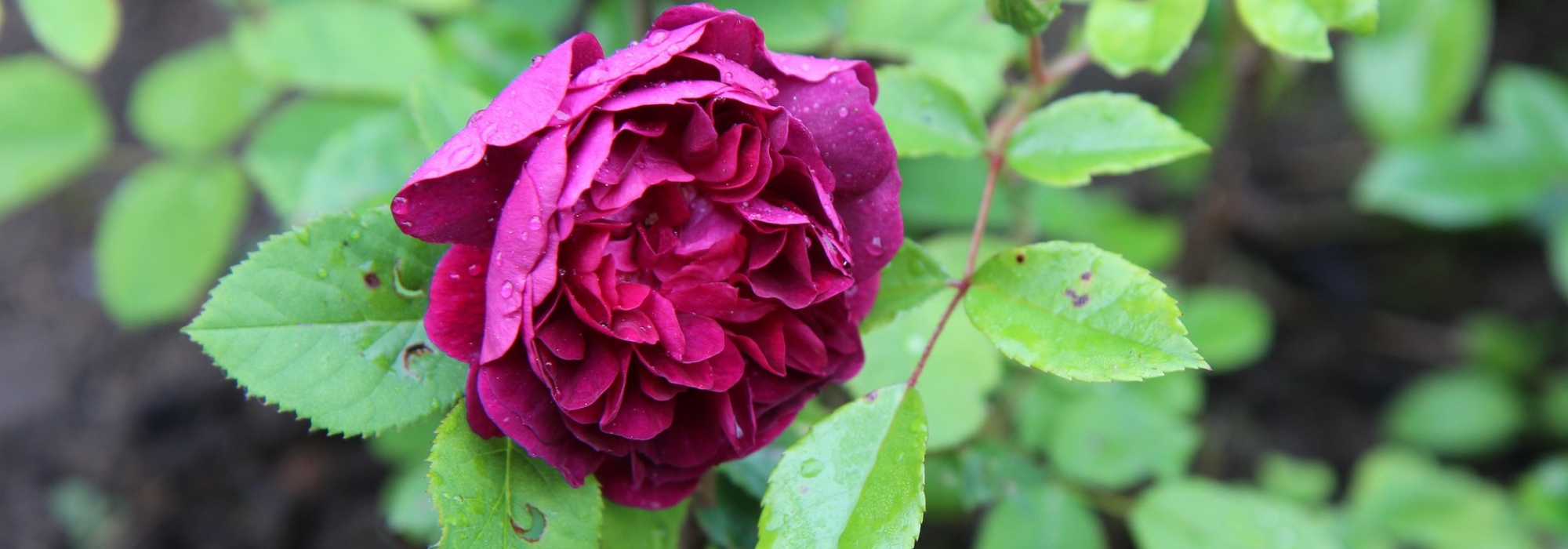
Old shrub roses: the essentials
A selection of tried-and-tested plants
Contents
We love old roses for their free, flexible, and natural habit, their roses often being highly fragrant, either single like dog roses or more or less double, even very double and voluptuous. They have a reputation for robustness and disease resistance, although this is sometimes a bit overestimated. Their flowering is usually unique, but generous. Some, however, are capable of blooming again one or more times from late spring to autumn.
What are the best old roses for our gardens? To be objective, our selection had to be independent of personal tastes and not take into account successes and failures that are more related to poor growing conditions than to the intrinsic value of the rose. Thus, it is quite logically among those that have never really disappeared from catalogues, despite the whims of fashion, but also among those that survive in old gardens left to themselves and in the silence of cemeteries, that we have chosen the most deserving old roses. Our selection also includes a few wonderful roses created after 1867, but linked to old roses by their characteristics.
Gallic roses (gallica)
Gallica rose is the ancestor of most European garden roses. Native to Southern and Central Europe and Asia Minor, extending to the Caucasus and Iran, it is a plant perfectly at ease in our climates.
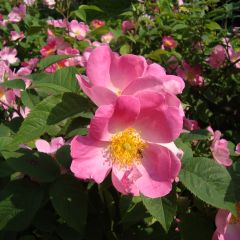
Rosa gallica Complicata - Old Gallic Rose
- Flowering time July
- Height at maturity 1,50 m
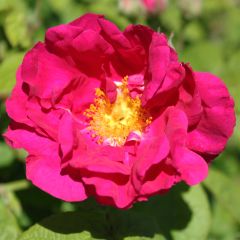
Rosa gallica Officinalis - Old Gallic Rose
- Flowering time July, August
- Height at maturity 90 cm
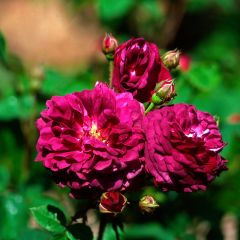
Rosa gallica Cardinal de Richelieu - Old Gallic Rose
- Flowering time July, August
- Height at maturity 1,20 m
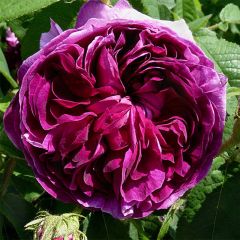
Rosa gallica Charles de Mills - Old Gallic Rose
- Flowering time July, August
- Height at maturity 1,20 m
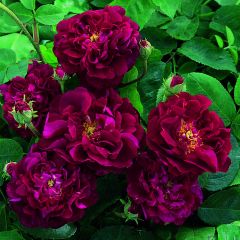
Rosa gallica Tuscany Superb - Gallic Rose
- Flowering time June, July
- Height at maturity 70 cm
Portland roses
These are closely related varieties to the Damask roses. Their flowers are borne on very short peduncles, making them appear nestled within the foliage. Compact and often perpetual, these roses are perfect for small gardens.
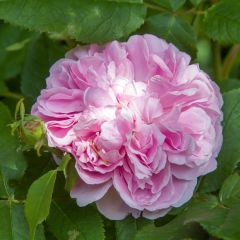
Rosa Jacques Cartier - Portland Rose
- Flowering time July to November
- Height at maturity 1,20 m
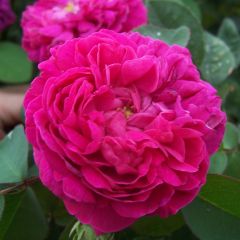
Rosa De Resht - Damask Rose
- Flowering time June to November
- Height at maturity 1 m
Discover other Traditional Roses
View all →Available in 1 sizes
Available in 2 sizes
Available in 2 sizes
Available in 2 sizes
Available in 0 sizes
Available in 2 sizes
Available in 2 sizes
Available in 2 sizes
Available in 2 sizes
Musk roses (moschata)
Issues for most climbing rose Trier, the moschata roses enjoyed wide diffusion. The creations of rose breeders Pemberton, and particularly Bentall, have never disappeared from catalogues. These roses bloom in more or less large, pleasantly scented pastel-coloured bouquets. Their flowering begins in June-July and continues until the frosts if the soil remains cool. The autumn flush is often generous.
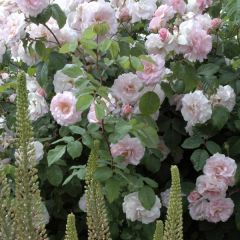
Rosa Cornelia
- Flowering time July to November
- Height at maturity 1,50 m
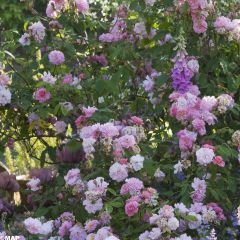
Rosa moschata Felicia - Musk Rose
- Flowering time July to December
- Height at maturity 1,50 m
Alba roses
The Alba Rose is probably a natural hybrid between Rosa canina (our wild dog rose) and the Damask rose. It forms large bushes that can reach 3 m in height with sturdy branches. The leaves are a remarkable blue-grey green, with a slightly “frosted” appearance, and they are free from diseases. These roses tolerate partial shade well.
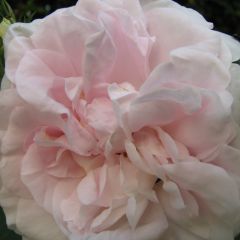
Rosa alba Great Maidens Blush
- Flowering time July, August
- Height at maturity 1,50 m
Centifolia roses (centifolia)
The Centifolia rose originated in Holland in the 16th century. It is a hybrid between the Damask rose and Rosa (x) alba. It is also known as cabbage rose or large Provence rose, with flowers that are often very large and composed of countless slightly wrinkled petals, resembling a cabbage. Its powerful scent of old rose is renowned. This ‘centfeuilles’ appears in countless still lifes from the 17th and 18th centuries, thus becoming the “rose of painters”.
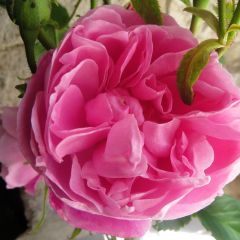
Rosa centifolia Fantin Latour - Cabbage Rose
- Flowering time July, August
- Height at maturity 1,50 m
Moss roses (centifolia muscosa)
Also known as Rosa (x) centifolia muscosa, the moss rose is simply a mutation of the cabbage rose. In this variety, the peduncle, calyx, and sepals of the flower are “mossy” rather than smooth like those of regular roses. More or less resinous and fragrant, this “moss” forms a kind of nest for the rose, enhancing its charm.
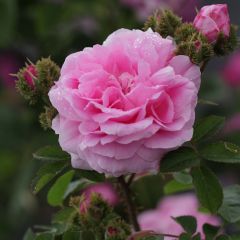
Rosa centifolia Cristata - Crested Moss Rose
- Flowering time July
- Height at maturity 1,20 m
Scotch roses, with burnet leaves
Rosa pimpinellifolia is a botanical species found in the mountains and coastlines of the Northern Hemisphere, both very hardy and well adapted to poor, rocky, or sandy soils. Its descendants have inherited its undemanding nature and its fine, light foliage, divided into numerous tiny leaflets. These roses, which are very healthy, require full sun to bloom well and should be pruned short every four to five years to remain dense.
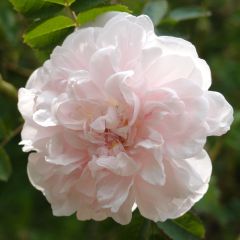
Rosa Stanwell Perpetual
- Flowering time July to December
- Height at maturity 1,50 m
Chinese roses
All Asian horticultural roses that contributed to the creation of roses in Europe have adorned the gardens of the Middle Empire for millennia. At the top of the list is Rosa chinensis from the gardens of Canton, Calcutta, and Singapore. While they bloom almost continuously, these roses fear very cold winters. In contrast, they cope well with heat and dry summers and are not very susceptible to rose diseases.
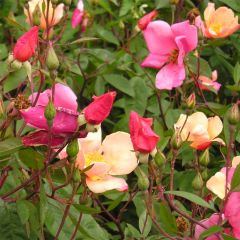
Rosa x chinensis 'Mutabilis' - China Rose
- Flowering time June to November
- Height at maturity 1,70 m
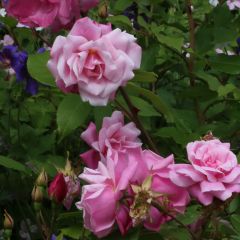
Rosa chinensis Old Blush - China Rose
- Flowering time June to November
- Height at maturity 1,20 m
Rugosa roses
Rosa rugosa, the Japanese rose, is a vigorous botanical species, highly thorny, perfectly hardy, and remarkably undemanding. Its descendants have inherited its characteristic foliage, cut into wrinkled leaflets, generally free from diseases and beautifully coloured in autumn. It has given rise to remarkable garden roses that require little maintenance. Their flowering is early and often perpetual. Spring pruning encourages flower production and helps maintain a denser habit.
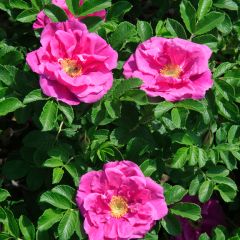
Rosa x rugosa 'Roseraie de l'Haÿ' - Rugosa Rose
- Flowering time June to November
- Height at maturity 2 m
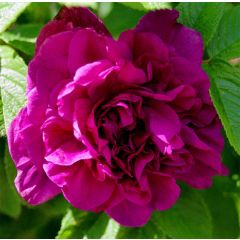
Rosa x rugosa 'Hansa' - Rugosa Rose
- Flowering time July to November
- Height at maturity 1,80 m
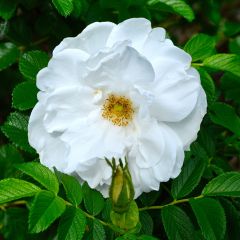
Rosa rugosa Blanc Double de Coubert
- Flowering time July to October
- Height at maturity 1,50 m
Bourbon roses
The ancestor of Bourbon roses seems to originate from Bourbon Island, now known as Réunion Island. This category includes a large number of famous old roses. Extremely varied in their appearance, they share a very pleasantly scented flowering and a certain sensitivity to rose diseases. They thrive in deep, fertile soil.
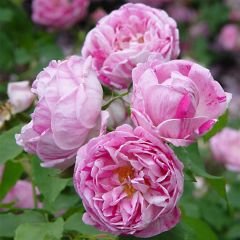
Rosa Honorine de Brabant - Bourbon Rose
- Flowering time August, October
- Height at maturity 1,50 m
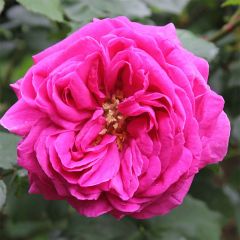
Rosa Mme Issac Pereire - Bourbon Rose
- Flowering time July to November
- Height at maturity 2,50 m
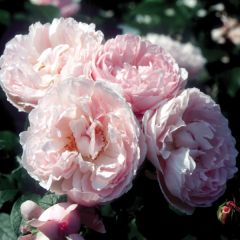
Rosa Souvenir de la Malmaison
- Flowering time June to November
- Height at maturity 1,30 m
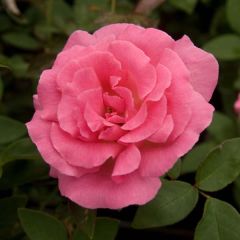
Rosa x Bourbon 'Zéphirine Drouhin' - Climbing Rose
- Flowering time July to November
- Height at maturity 3 m
Hybrid remontant roses and Hybrid Tea roses
Called formerly ‘Hybrid Perpetual’ in Britain or hybrids perpetual here, the tea hybrid roses with complex genealogy do not bloom continuously. Their June flowering is exceptionally generous, while the late summer bloom is often more modest. Naturally forming large bushes, these vigorous and stocky roses dressed in large leaves are magnificent at the back of borders, in groups of three, or integrated into a free-standing hedge. They require fertile soil to support their flowering. Many show a certain sensitivity to rose diseases.
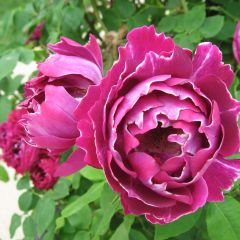
Rosa Baron Girod de l'Ain
- Flowering time July to October
- Height at maturity 1 m
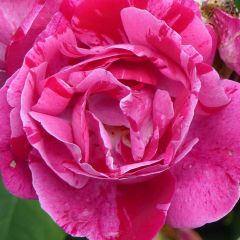
Rosa Ferdinand Pichard
- Flowering time July to November
- Height at maturity 1,40 m
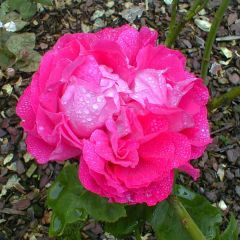
Rosa Paul Neyron - Repeat Flowering Rose
- Flowering time July to November
- Height at maturity 1,70 m
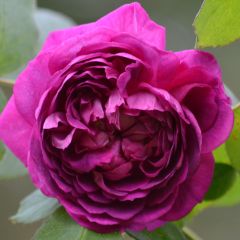
Rosa Reine des Violettes
- Flowering time June to November
- Height at maturity 1,35 m
Using Old Shrub Roses Effectively
The lush foliage and abundant fragrant flowering of old bush roses make them ideally suited for grouped planting in beds or in a free-standing hedge, which will then become impenetrable. This creates a very ornamental mass effect, and it can remain in bloom for a long time if you choose varieties with staggered flowering. In the garden, a bed of roses should be set against a fairly neutral backdrop of evergreen bushes or conifers, for example. Avoid placing your roses along the edge of a narrow path to escape scratches! It is also preferable to associate them with other bushes, especially in a small garden: a mass of roses will create too strong an impact during flowering and will leave the decor bare and sad in winter. Perennials make lovely companions with roses, as they are excellent companions for old roses, living for many years without requiring much maintenance.
Did you know?
While it is generally accepted that the era of old roses, from a historical perspective, came to an end with the dawn of the 19th century, from an emotional standpoint, it has never faded in the hearts of flower enthusiasts. The term ‘old rose’ is traditionally reserved for varieties created without the influence of ‘exotic’ perpetual roses, such as the Chinese roses. More specifically, an old rose is one that was born before 1867, that is to say, before the introduction of the rose ‘La France’, the first Hybrid Tea. For the plant enthusiast, however, an old rose embodies more of a style than a specific era, as evidenced by the numerous “modern roses in the old style” created over the past twenty or thirty years. The style of these bushes in their own right is a beautiful combination of softness, flexibility, and a character that is both assertive and accommodating!
- Subscribe!
- Contents
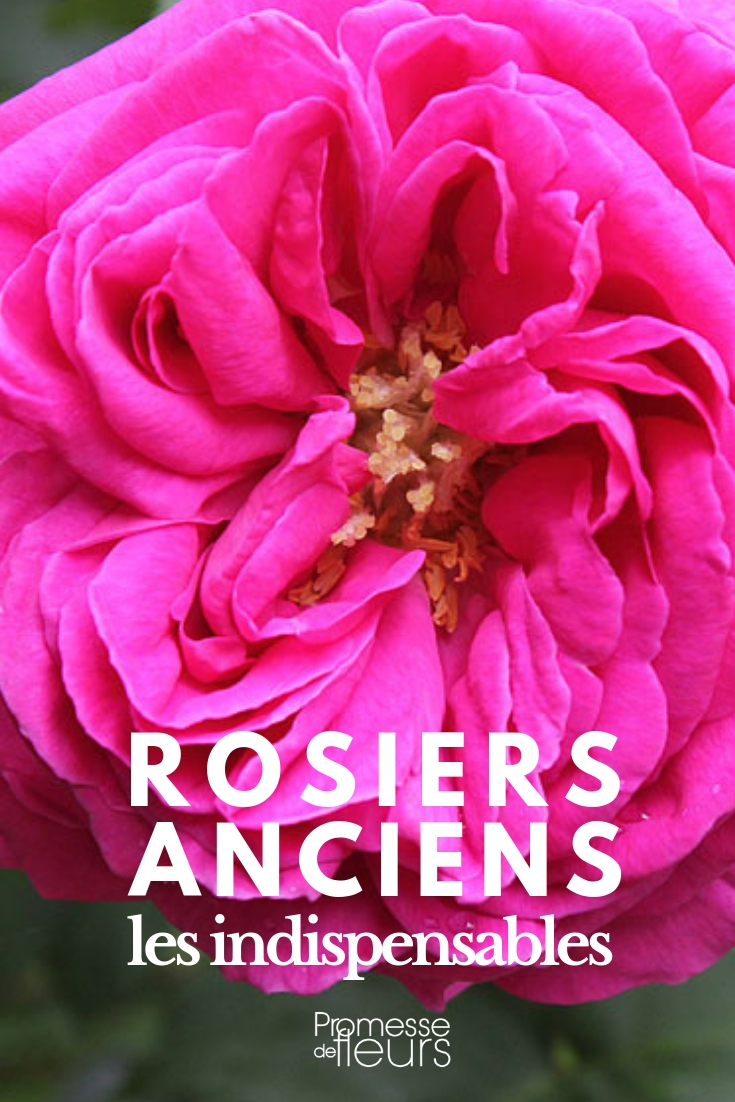































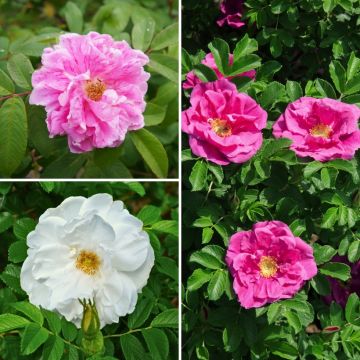
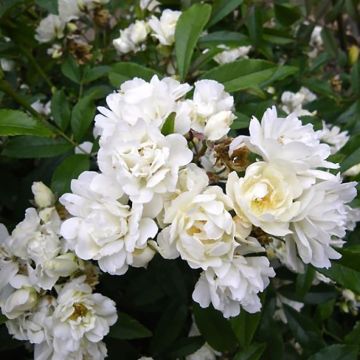
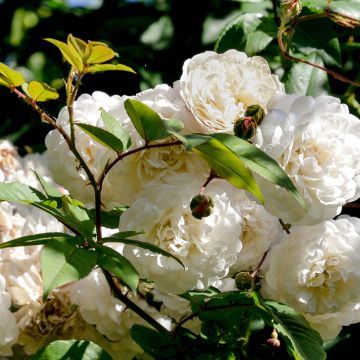
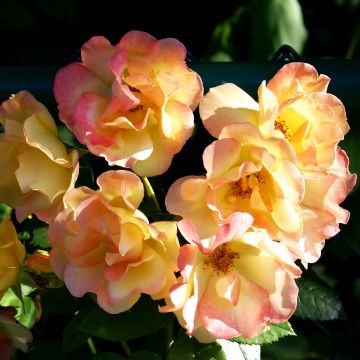

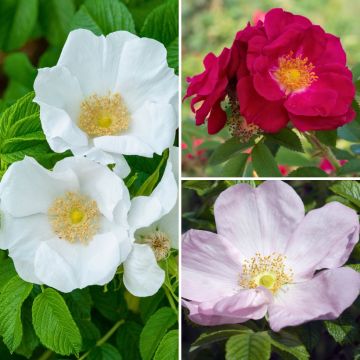
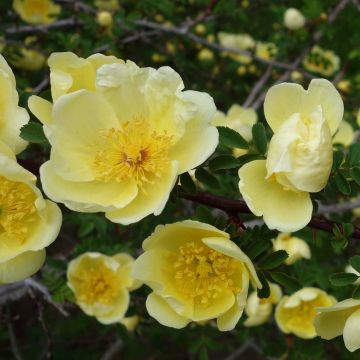
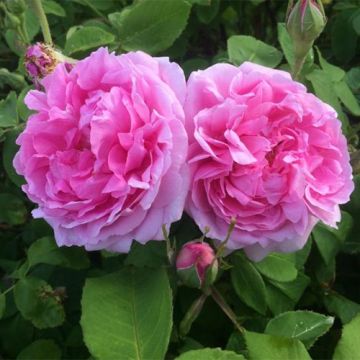
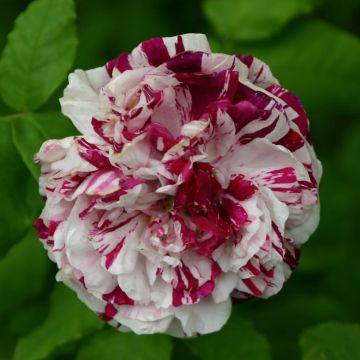
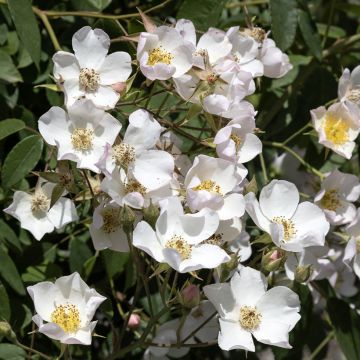
Comments